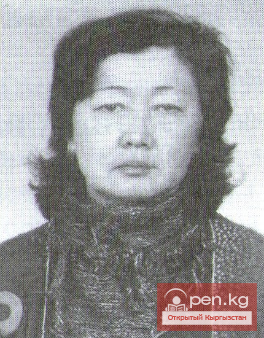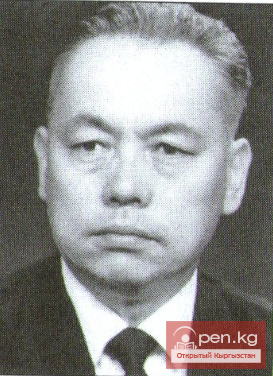API error: no response...

Diversity of Monumental Painting and Decorative Plastic Arts. In the 1960s, the traditional...

Joоmart Kadraliev also resorts to the language of allegory, but his allegories have a more...

The Independence of Artistic Thinking of Yevgeny Stepanovich Herdyuk. Yevgeny Stepanovich Herdyuk...

Mosaic Masters. In the 1980s, Momunbek Akmatkulov began working in the field of monumental...

Mosaic of Satyr Aitiev The mosaic by Satyr Aitiev on the laboratory building of the Kyrgyz State...

Painter and easel artist S. Bakashev with a heightened sense of plasticity Sabitjan Bakashev...

Torobekova Chynara Kerimkulovna Painter. Born on August 18, 1950, in the village of Bystrovka,...

Artistic and Stylistic Range of Young Artists' Works Possessing a gift for painting, most of...

Hertsen Theodor Theodorovich Monumentalist. Graphic artist. Painter. People's Artist of the...

The Versatility of Alexei Nikolaevich Kamensky. Alexei Nikolaevich Kamensky has developed into a...

Bakashov Sabitjan Monumentalist. Painter. Born in 1941 in the village of Ak-Terek, Ton District,...

Monumentalists of the New Generation in Kyrgyzstan In the 1970s, with the arrival of sculptors and...

Tsyrendorzhieva Diana Painter. Born on November 10, 1948, in the village of Kyren, Buryatia. In...

One of the leading masters of drawing in the collective of graphic artists of Kyrgyzstan in the...

Creative Team on a Breakthrough to Kyrgyzstan The period under consideration is a time of intense...

If A. Voronin early established himself as a realist artist with a distinctive creative face, then...

The monumentalist artist Vladimir Georgievich Butorin most vividly and originally expressed...
API error: no response...

Success was more easily achieved through traditional means of plein air painting, especially...
API error: no response...

Kasyimov Toktogul Applied artist. Painter. Born on June 15, 1943, in the village of Kyzyl-Suu,...

Sabitjan Bakashev places great importance on the beauty of pictorial texture and the brightness of...

Harmoniously solved tasks by a team of painters. In the first half of the 1960s, the team in...

Butorin Vladimir Georgievich Monumentalist. Painter. Honored Cultural Worker of the Kyrgyz...

Academicism of Kyrgyz Painters Kulchoro Kerimbekov, Jakul Kozakhmetov, and Altymysh Usubaliev, who...

Moldakhmatov Zhyldyzbek Asanbekovich Monumentalist. Painter. Honored Worker of Culture of the...
Curl error: HTTP/2 stream 0 was not closed cleanly: INTERNAL_ERROR (err 2)...

Belek Jumabaev, endowed with vivid imagination and sharp observation, was the first to paint...

The Beginning of the Development of the Tombstone Genre. In the last decade, the development of...

Tursunbek Koichiev addressed the revolutionary theme in a monumental and generalized manner in his...

Moldakhmatov Asanbek (1923-1993) Theater artist. Painter. Honored Artist of the Kyrgyz SSR. Born...

Bokonbaev Gamal Japievich Painter. Born on November 26, 1958, in the city of Frunze. In 1981, he...

Bekov Kadyr Jalilovich Painter, monumental artist. Born on January 18, 1956, in the city of...

Mikhalev Andrey Nikolaevich (1910-1981) Graphic artist. People's Artist of the Kyrgyz SSR. He...

On March 5, a collection exhibition of paintings dedicated to the 100th anniversary of Fedor...

Vladimir Grigoryevich Rogachev Graphic artist. Born in 1928 in Kokshetau, Kazakh SSR. Lived in...

Integration of Artistic Cultures The international integration of artistic cultures has deepened...

Until the 1960s, Ignatiev's work predominantly featured Kyrgyz themes, primarily related to...

Complex of sculptural works at the Kirov Reservoir in the Talas region. A significant milestone in...

In the 1960s, in Kyrgyzstan, as in other republics of the country, a new stage in the development...

The contradictory search for Sapara Torobekov. In his painting, two lines develop: tonal-plein...

Kyrgyz Masters of the Easel In the 1970s, Murat Bekdzhanov established himself as a fine...

Monumental Form of Commemorating the Fallen Heroes. An important place in the monumental sculpture...

The creativity of Gapar Aitiev in the 1960s and 70s was exceptionally fruitful: it was the peak of...

Chokmorov Suimenkul (1939-1992) Painter. People's Artist of the USSR. Laureate of the State...

Truskovskiy Lev Gavrilovich (1908-1980) Graphic artist. Born on July 31, 1908, in the city of...

Monumental forms of art in Kyrgyzstan during the 1960s to 1980s emerged at the forefront of...